No Man is Poor Who Has Fronds
Even gardeners like myself who gravitate to bright colors realize that from time to time you have to pause to appreciate the more subtle beauties of foliage. May is a good time to do that, because the fronds and leaves are so fresh and the green-deprived winter months are not yet a distant memory.
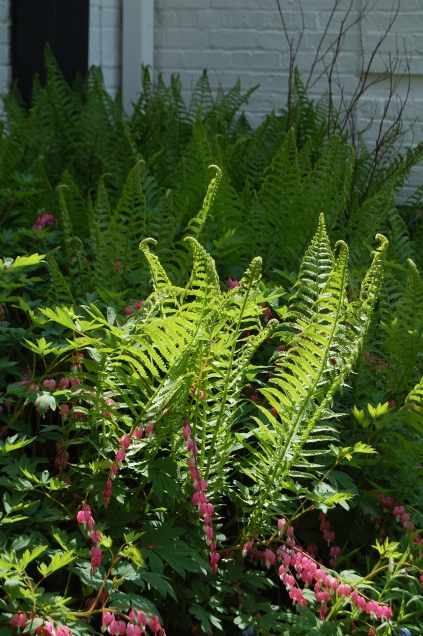
May is certainly a good month for ferns, especially the ostrich ferns (Matteuccia struthiopteris) that emerge early in the month and then start a mad dash to grow as big as they possibly can, which is pretty big (up to 6′, though mine stop at about 4′). A friend of mine recently got a fern for the garden as a mother’s day gift, she was worried that it required too much coddling. I should have offered her a free ostrich fern, which will thrive pretty much anywhere there is shade and moist soil.
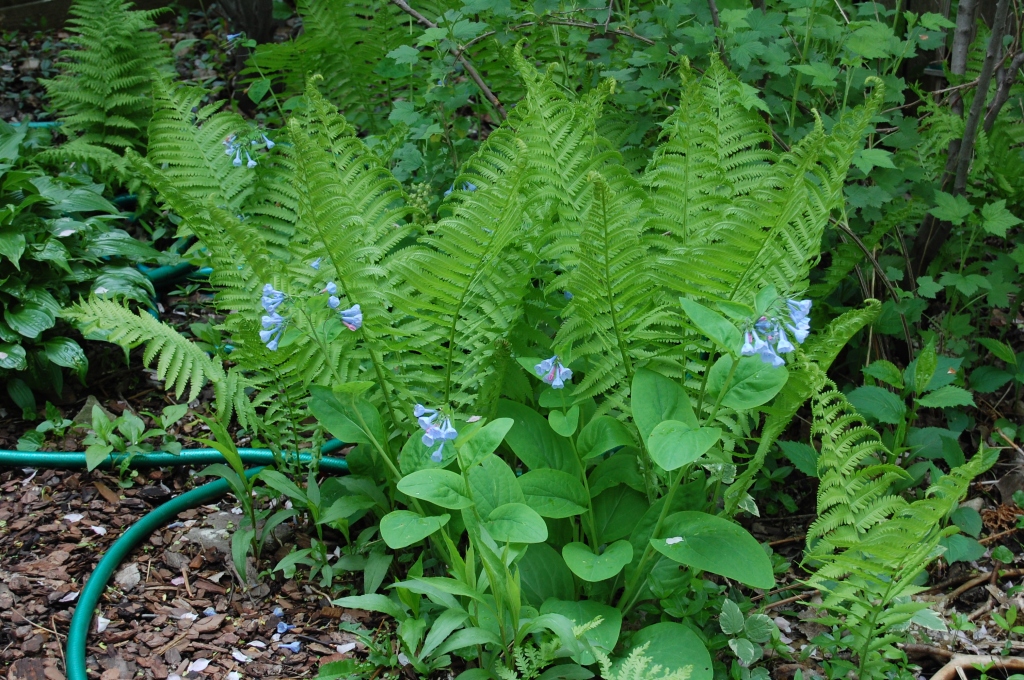
There are also some inherited ferns in the back garden. Not sure what species these are.
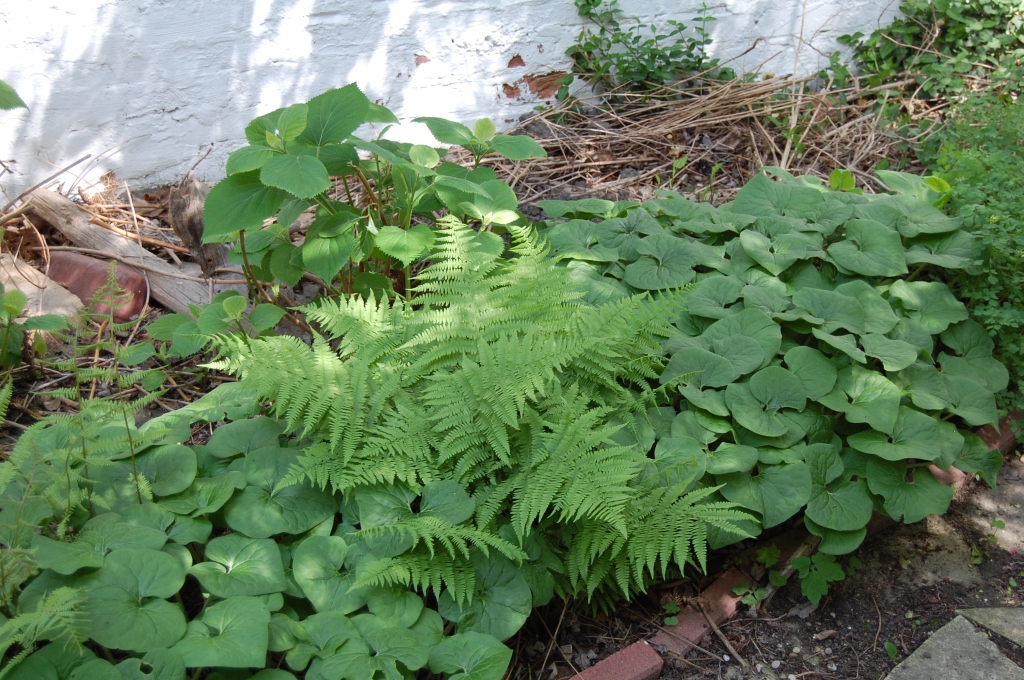
There are also lady ferns (Athyrium filix-femina) growing in several spots, including with these wild ginger (Asarum canadensis) on the west side of the house. Lady ferns are a smaller fern but its delicate looks are deceptive – it is a fern that can take care of itself. By the way, for a long time I thought it was felix-femina, not filix. I suspected that felix-femina meant cat lady, because of, you know, Felix the Cat. However, I recently discovered that felix means lucky and filix just means fern. So Athyrium filix-femina is not the cat lady fern, which is too bad when you think about it.
Some people prefer the European wild ginger (Asarum europaeum), which has smaller, shiny leaves. For myself, I like the downy texture and soft green of the native North American wild ginger. Both plants make excellent groundcovers for shade. By the way, neither is actually a culinary ginger, but the roots do have a ginger smell.
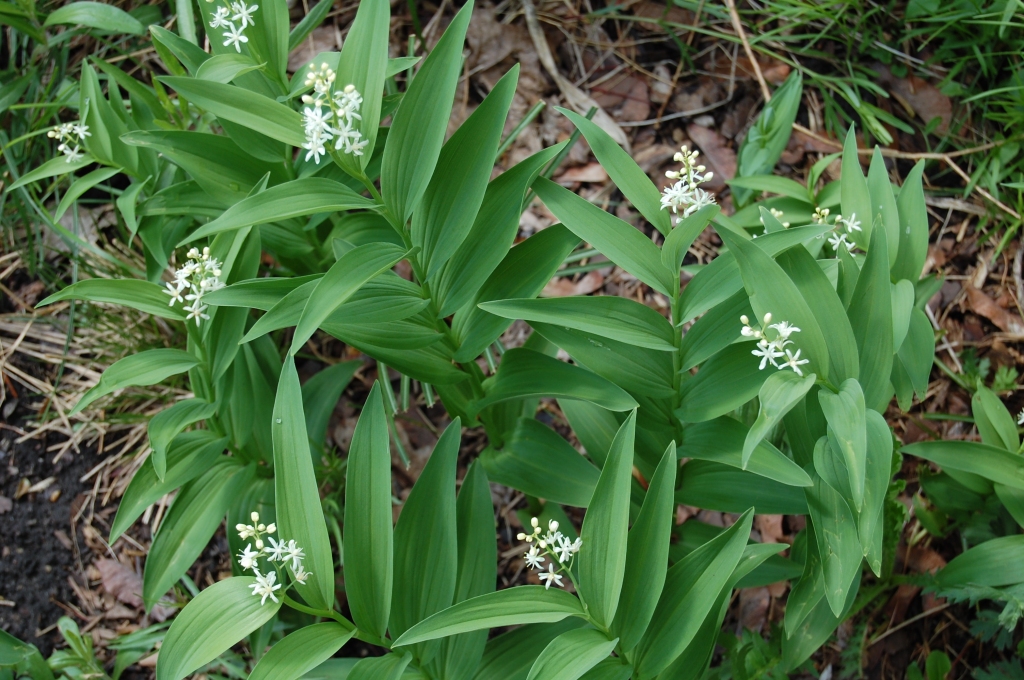
Starry solomon’s plume (Smilacena stellata) has tiny white flowers but its best features are its foliage and the striped berries that emerge in summer. This plant does not grow thickly enough to be used as a ground cover and needs to be mixed with others.
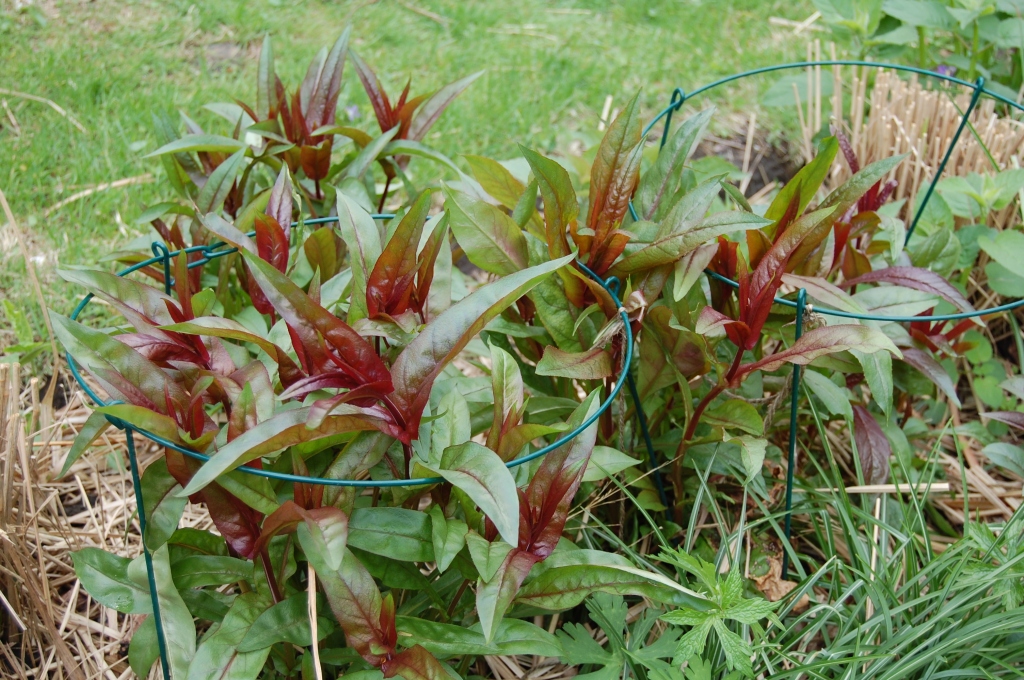
Penstemon ‘Husker Red’ (Penstemon digitalis) won’t bloom for about another month but the reddish foliage provides a bit of drama.

I used to be prejudiced against Epimediums, however lately I have come to appreciate their willingness to grow in dry shade where others will languish and die. And I suppose they are attractive in their way. This is an inherited Epimedium of unknown variety.
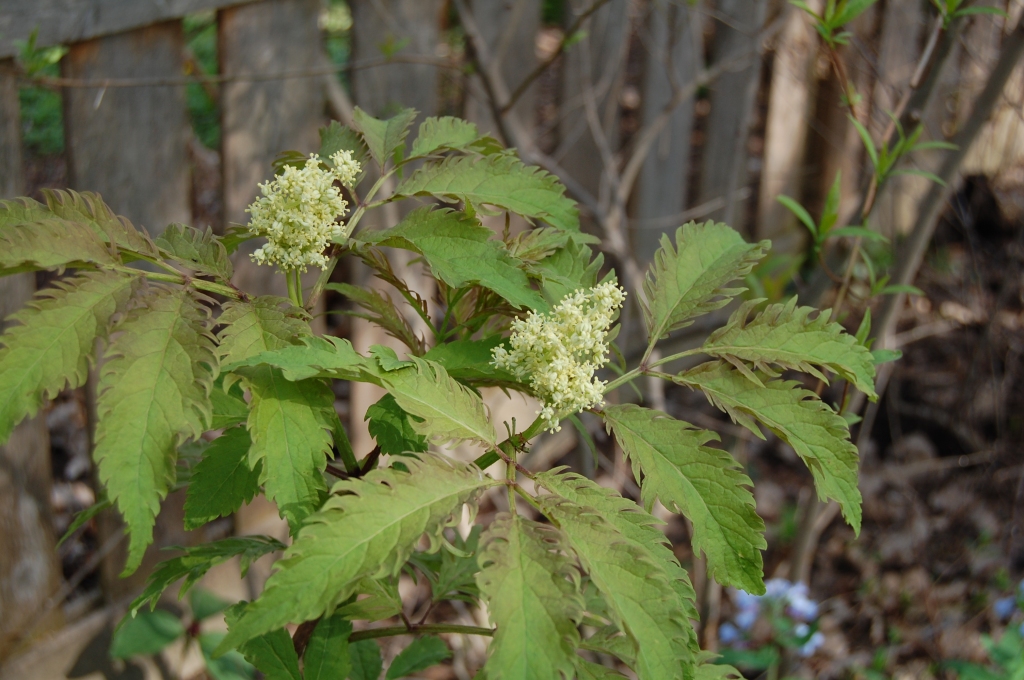
I like my ‘Sutherland Gold’ red elderberry (Sambucus racemosa), which is entering its second season in my garden. The flowers aren’t too exciting, but the foliage is interesting and I have a fondness for plants with red berries. I also have several native red elderberries on the west side of the house.
This post is a contribution to Garden Bloggers’ Foliage Day, which is sponsored by Christina at My Hesperides Garden. Click the link to see more exciting and appealing foliage.





Hah! Your musing about the cat lady fern had me laughing out loud.
Have you ever thought about the enormous differences between Cat Woman and a cat lady? Isn’t that odd?
Your ferns look great next to the Dicentra. I have the same Ostrich ferns (in full sun!) and they get to about 5 ft. They get a bit burnt in summer, but last August I cut them back and they regenerated within a couple of weeks. Amazing plants. They would love to spread too, but I have to be brutal and dig up the pioneering ones every spring!
Mine grow in a good bit of shade but even they get crackly by August if the summer is at all dry.
Thanks for joining in this month Jason. I know you thought foliage didn’t interest you but the evidence is that you are just choosing good foliage without even thinking about it (good gardener that you are!). I remember falling in love with ferns the first time I visited Sissinghurst in spring. The ferns between the hazels was an amazing sight, I can still see it in my mind’s eye. So I love all your ferns.
Even in September I remember lush green stands of ferns in the shady gardens.
I absolutely love ferns too, but I struggle to remember their names. This means that I find a beautiful new one, buy it and bring it home, only to find that I already have it. Obviously I will never forget the cat lady fern now. So that is easy. The ostrich fern is another easy one and spreads so obligingly. I love the Royal fern too. It grows so tall in a damp soil and does look very regal.
For some reason, ferns in plant nurseries tend to be very expensive. They are more affordable when ordered online. Of course, once you have some ferns like the ostrich fern you never have to buy another one, as they get busy reproducing themselves.
They are expensive here too, I wish you could prpogate them by sticking a frond in a pot but unfortunately you have to do complicated and mysterious things with spores.
I love ferns for their acid greens in spring, for the backdrop they give for other plants, I wouldn’t garden without them!
Certainly they are essential for the shade garden!
You have a lovely collection of beautiful and different foliage. Enjoy.
Thanks, I intend to!
The barrenwort is a ringer for Epimedium rubrum. Your ferns are especially lush and lovely. You should consider adding ‘Ghost’ which is a cross between the lady fern and the Japanese painted fern. It is to die for, errect form with gray-green foliage, but with the vigor of the native. It would brighten some of your dark areas.
I bet you are right about Epimedium rubrum.
I love ferns but have had to pull some out this year because they have taken over a couple of areas. And, I have to admit I really like European Ginger. 🙂
The European ginger is nice but I put I’d rather have the canadensis.
I think you should get the prize for best title of the month. Or maybe year. Oh- and the ferns are other foliage are lovely too! I used to think ferns were boring, but now I am an addict.
All modesty aside, I am quite pleased with that title. You are addicted to ferns, I am addicted to puns.
Some handsome ferns there, I just love the way they uncurl, they are such ancient plants, they seem to survive everywhere.xxx
They do have a prehistoric feel to them.
When I lived on the coast I would go for a walk and everything was giant hemlocks. mosses and ferns. Everything was green and it was really quite peaceful. I love color but sometimes green is just right. I noticed you have the Penstemon in cages. I imagine that you are an expert on supporting plants if the rumours about Chicago’s winds are true. I’ve been looking for ideas and that should have been obvious but it wasn’t. (Not sure why I thought cages are limited to vegetables ….. doh)
I’ve been using more cages on different flowers. They’re not as obvious once the plants grow in more.
Fine information and photos, but great title.
I think so, too!
I like ferns used as a backdrop for a garden. If ostrich ferns do well there you might be able to grow some trilliums or Jack in the pulpit (Arisaema triphyllum.)
It’s been a long time since I last thought of Felix the cat!
I do have some Trilliums but Jack in the Pulpit has always gotten infected with rust in my garden.
Thanks for explaining about the wild ginger. I saw a lot of it on a recent garden tour but now don’t know which kind it was. I would have expected the native but the leaves were glossy. Also the fern with Virginia bluebells is terrific. What hose?
I think the European is more common because it’s so glossy and is a bit neater.
As much as I love the bright colors, some of my favorite parts of the garden are my hostas and fern areas. I love all the shades of green and the variety of textures.
I know what you mean.
Great title and photos! The Ferns are taking over here, but I’m OK with that for the most part. Your garden looks fabulous this time of year!
The ferns do have expansionist tendencies, soon I’m going to have to start digging them out.
Nice foliage Jason. I liked the support you have for penstemon. My ferns are growing too opening their leaves. Your garden is getting summer garden.
Hi Nadezda. There is beginning to be a hint of summer in the garden.
Hi Jason, there’s a strip of border along the side access that is wet and shady and I’m planning to have ferns right along it. Those ostrich ferns look like they’re up to the task of filling the area.
Sounds like it would be a good fit, Sunil.
Mmm, lots of lovely leaf action, your wild ginger is magnificent, I want to get the European version for my garden. I love the Sambucus racemosa foliage, I might just have to make a note of that… I think your mystery fern is Dryopteris, it certainly looks very like the fern I have popping up all over my own garden, anyway.
I was thinking it could be Dryopteris, but I need to learn how to tell ferns apart. Regarding the elderberry, I will say it flowered sparsely and it looks like it will not be producing berries this summer – maybe next year.
Do you ever overwinter plants in a mulch pile, uncover them in spring and wonder what in the heck they were and why did I overwinter them? Well, I have to give you a huge THANK YOU for identifying the Sambucus racemosa that I overwintered last year. I was just about the throw the thing out!
Thank you, thank you, thank you!
Oops, see below.
Gosh, you’re welcome. I have never overwintered plants in a mulch pile, but after this last winter. I may start.
“Beautiful foliage Jason” he said frondly.
You may find your unknown Epimedium just okay, but I like the reddish edges. I’ve just come to appreciate them for their dry shade tolerance, and I’m trying to encourage the Mulch Man to incorporate more of the PNW native species into his Northwest Territory.
Oh, and a shout-out for your clever title. I like how your brain works, Jason.
I adore ferns and will profile on in June. You have great foliage. I love the flower and foliage of my species elderberry and hope it is growing this year….I have lost so many things.